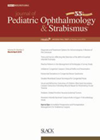
Journal Reviews
What factors influence attendance at retinopathy of prematurity screening follow-up?
The authors present a retrospective medical notes review of babies attending outpatient appointments for retinopathy of prematurity (ROP) examination, over a 12-month period. The aim of the study was to assess compliance with these appointments at a single centre. Data...
The use of virtual reality in paediatric ophthalmology
The purpose of this study was to investigate the utility of virtual reality (VR) in the broader field of paediatric ophthalmology with review of examination, screening, diagnosis, prevention and treatment. This review also explores the potential of eye tracking used...
Female leadership within paediatric ophthalmology in the US
This study explores female leadership within paediatric ophthalmology services in the US and whether the findings reflect the equal gender composition of the paediatric ophthalmology subspeciality workforce. This was a cross-sectional study with data collection from publicly available online sources...
Associations with non-attendance for paediatric patients attending eye appointments
In this study the aim was to identify patient demographic, socioeconomic and appointment characteristics associated with missed appointments in paediatric ophthalmology at a tertiary care academic ophthalmology centre and assess appointment reminder method effects. This was a retrospective cross-sectional study...
Piloting myopic control glasses effects on axial length under mesopic conditions
This study aimed to pilot whether axial length reduces when being treated with myopia control glasses in mesopic conditions. Participants were required to have single-vision glasses with spherical equivalent between -1.00 and -5.00 dioptres, astigmatism less than -1.00 dioptre, a...
Augmented surgery with BTA for large angle strabismus correction
This retrospective study reports the results of botulinum toxin A (BTA) augmented bilateral recession or monocular recession / resection (RR) for patients with large angle strabismus. Twenty-four patients were recruited: 10 female, mean age 9.2 ±13.6 years, 20 esotropia and...
Changes in retinal and choroidal microcirculation after strabismus surgery
The aim was to evaluate retinal and choroidal microcirculation using optical coherence tomography angiography after strabismus surgery. This was a cross-sectional observation study of 44 eyes of 44 patients. Patients were split into three groups: (1) one-muscle horizontal surgery (n=9);...
Use of the Mendonca strabismus forceps in locating and measuring muscle insertions
The authors aimed to compare the reliability of the Mendonca strabismus forceps vs intraoperative calliper measurements for determining the distance from the limbus to the insertion of the extraocular muscles in patients undergoing strabismus surgery. This was a prospective observation...
Reporting the development and pilot use of fixable surgical instruments
This study reports the development of instruments to substitute traction sutures during strabismus surgery and to act in place of surgical assistance. Three types of instruments were developed: (1) fixable multi-functional forceps; (2) fixable muscle hook; and (3) fixable retractor....
Associations between cerebral vascular malformations and retinal venous malformations
The authors present a retrospective medical notes review which aimed to understand associations between retinal venous malformations (RVM) and cerebral vascular malformations (CVM). Cases of known CVM over a four-year period were identified. The data extracted from medical records included...
Risk for systemic hypertension in ROP with IVB or laser therapy
The purpose of this study was to investigate whether there is an association between intravenous bevacizumab (IVB) and hypertension among infants with severe retinopathy of prematurity (ROP) and comparing those treated with IVB to those treated with laser, or infants...
Reattachment rate with pneumatic retinopexy vs pars plana vitrectomy for single break rhegmatogenous retinal detachment
This is a post-hoc analysis of two clinical trials, including patients who underwent pneumatic retinopexy (PnR) vs pars plana vitrectomy (PPV) and had met the management of primary rhegmatogenous retinal detachment outcomes randomised trial (PIVOT) criteria with a single break...









